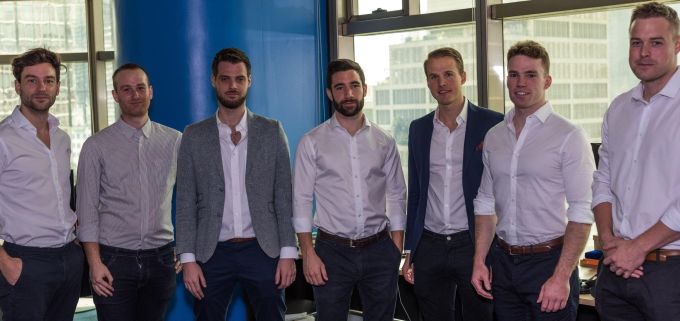We’re kicking off Startup Battlefield MENA here in Beirut, where 15 startups will be taking the stage, along with speakers from Facebook (our partner on the event through its FB Start program), Instabug, Eventus, Wuzzuf, Careem and Myki.
For those of you who can’t be here in person, check back on TechCrunch later today, where we’ll be sharing videos and other highlights from the event. And of course, announcing the winner!
For the first time, TechCrunch is holding Startup Battlefield MENA in partnership with FB Start. After scouring does dozens of countries, sifting through hundreds and hundreds of extremely talented startups, TechCrunch selected 15 elite companies across the region to compete in prestigious global Startup Battlefield competition for $25,000 equity-free prize, a trip for 2 to TechCrunch Disrupt San Francisco 2019 and the coveted title of “Middle East & North Africa’s Favorite Startup”.
After weeks of intense coaching from the TC team, these startups are primed for international launch. For the semi-final round, each founder will pitch for 6 minutes, with a live demo on stage, followed by 6 minutes of Q&A with our expert panel of judges. After, our judges will deliberate and 5 teams will be selected to compete in the final round of Startup Battlefield – same pitch, but with an even more intense Q&A.
So, who are these chosen few? From creating new forms of fast setting concrete to quickly build houses in areas recovering from natural disasters to agricultural monitoring technology preventing water-related conflict, this batch of companies is truly changing the world. Companies also include financial investment AI platforms, edible insect based protein powder, to culturally relevant dating apps. Founders in the automotive industry are poised to change everything from how we pick the cars we want to buy to how we optimize their maintenance. From innovations to hydroponic gardens, educational tutoring platforms to modernizing technology for hotel chains, Startup Battlefield MENA is set to highlight the regions most promising startups. Videos from the event will be posted on TechCrunch.com after the event. Stay tuned!
Session 1: 9:30am – 10:30am
Buildink, Harmonica, MaterialSolved, MoneyFellows, Neotic AI
Session 2: 11:10am – 12:10am
Nutransa, Seabex by IT Grapes, IN2, Seez, Autotell
Session 3: 1:40pm – 2:40pm
Synkers, Verbose, Makerbrane, Argineering, PureHarvest
Welcome Remarks
9:05 am – 9:25 am
Infrastructure and Connectivity: A Regional Perspective with Imad Kreidieh (Ogero Telecom) and Ari Kesisoglu (Facebook)
Access to the internet and connectivity is the driving force for the 4th industrial revolution. Join a conversation about how the Telco industry is changing in Lebanon and the region, and what that means for businesses and consumers. Sponsored by Facebook
9:25 am – 10:30 am
Startup Battlefield Competition – Flight #1
TechCrunch’s iconic startup competition is here and for the first time in MENA, as entrepreneurs from around the region pitch expert judges and vie for US$25,000 no-equity cash prize and a trip for two to compete in the Startup Battlefield at TechCrunch Disrupt in 2019.
10:30 am – 10:50 am
BREAK
10:50 am – 11:10 am
Jennifer Fong (Facebook)
Hear from Facebook’s head of the Developer Circles Program about their work with developers, startups and businesses to build, grow, measure, and monetize using Facebook and Messenger platform products. Sponsored by Facebook
11:10 am – 12:10 am
Startup Battlefield Competition – Flight #2
TechCrunch’s iconic startup competition is here and for the first time in MENA, as entrepreneurs from around the region pitch expert judges and vie for US$25,000 no-equity cash prize and a trip for two to compete in the Startup Battlefield at TechCrunch Disrupt in 2019.
12:10 pm – 1:10 pm
BREAK
12:15 pm – 1:15 pm
Workshop: Automated Driving Mobility in MENA with Mandali Khalesi (Toyota)
Toyota’s Global Head of Automated Driving Mobility and Innovation will share Toyota’s latest automated driving research findings and its plans for the future. There will be 30 minutes set aside for consultation, where the audience will have the opportunity to advise Toyota on both how it should go about developing automated driving mobility for MENA, as well as how best to work together with entrepreneurs in the region.
1:15 pm – 1:40 pm
Lessons 10 Years On with Omar Gabr (Instabug), Nour Al Hassan (Tarjama), Mai Medhat (Eventtus) and Ameer Sherif (Wuzzuf) – Moderated by Editor at Large Mike Butcher
Ten years ago the Middle East and North Africa’s tech ecosystem was worth perhaps tens of millions of dollars. Today it’s in the hundreds of millions, and beyond. A decade ago the societal landscape was very different from today. Let’s discuss the huge changes that have happened and challenges and opportunities ahead.
1:40 pm – 2:40 pm
Startup Battlefield Competition – Flight #3
TechCrunch’s iconic startup competition is here and for the first time in MENA, as entrepreneurs from around the region pitch expert judges and vie for US$25,000 no-equity cash prize and a trip for two to compete in the Startup Battlefield at TechCrunch Disrupt in 2019.
2:40 pm – 3:00 pm
Fireside Chat with Magnus Olsson (Careem) – Moderated by Managing Editor Matt Burns
How do you scale a big startup in MENA? We hear from Magnus Olsson, founder and Managing Director of ride-hailing giant Careem on how they joined the unicorn club with Lyft and Uber.
3:00 pm – 3:25 pm
Where Will the Exits Come From with Henri Asseliy (Leap Ventures), Priscilla Elora Sharuk (Myki), and Kenza Lahlou (Outlierz Ventures) – Moderated by News Editor Ingrid Lunden
Both VCs and startups in MENA alike are furiously building the companies of the future. But you can’t have a startup without an acquisition or IPO, so where are they going to come from? We’ll hear from both the founder and investor perspectives.
3:25 pm – 4:40 pm
Startup Battlefield Competition – Final Round
TechCrunch’s iconic startup competition is here and for the first time in MENA, as entrepreneurs from around the region pitch expert judges and vie for US$25,000 no-equity cash prize and a trip for two to compete in the Startup Battlefield at TechCrunch Disrupt in 2019.
4:40 pm – 4:55 pm
BREAK
4:55 pm – 5:20 pm
MENA Content Plays with Paul Chucrallah (BeryTech Fund), Hussam Hammo (Tamatem) and Rami Al Qawasmi (Mawdoo3) – Moderated by News Editor Ingrid Lunden
A little-known fact about the MENA market is the sheer lack of Arabic language content online for consumers, whether it be media, music, games or events. Arabic-specific sites have appeared, tailor-made to the market. We’ll get the perspective of key entrepreneurs in this space.
5:20 pm – 5:35 pm
Startup Battlefield Closing Awards Ceremony
Watch the crowning of the latest winner of the Startup Battlefield







